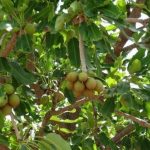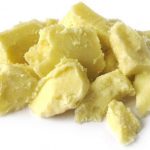Vitellaria paradoxa (synonym Butyrospermum paradoxum) or Sheanut tree, Shea-butter tree, Shea tree, Bambouk butter tree, Galam butter tree (English) or Kadanya, Man ka’danya, Dan káraye (Hausa) or Okwuma (Igbo) or Akú malapa, Emi-em, Ora bòta (Yoruba) or Masłosz Parka (Polish): A multipurpose African plant with international recognition
Description and Occurrence of Shea Butter Tree
Vitellaria paradoxa is a small to medium-sized tree (min. 7) 10-15 (max. 25) m high; much branched, dense, spreading, round to hemispherical crown. In mature trees the bole is short, usually 3-4 m but exceptionally 8 m, with a diameter ranging from 0.3 to 1 m, but most frequently 0.6 m. The bark is conspicuously thick, corky, horizontally and longitudinally deeply fissured; protects older trees against bush fires. Slash pale pink, secreting white latex, as do broken twigs or petioles.

This tree, being light-demanding, is one of the most common components of the Sahelian Parklands and occurs over very large areas of Africa.
Kadanya forms extensive pure stands in some areas but often also associated with other trees, such as Parkia biglobosa (dorowa in Hausa). Avoids swampy areas, those liable to flooding for any length of time, moist heavy loam soils or watercourses.
The extensive root system is essential for survival in the 5-7-month dry seasons of savannah climates. Can withstand quite severe fires. The plant prefers dry and sandy clay soils with a good humus cover but also tolerates stony sites and lateritic subsoil although reacting with lower yields.
Kadanya is native to: Benin, Burkina Faso, Cameroon, Chad, Cote d’Ivoire, Ghana, Guinea, Mali, Niger, Nigeria, Senegal, Sudan, Togo and Uganda.
Uses of Shea Butter: Medicinal, Nutritional Industrial and Economic
Vitellaria paradoxa nuts are used for oil extraction for cooking, soap and cosmetics. Shea butter extracted from the nuts is one of the most affordable and widely used vegetable fats in the Sahel. Today, Shea nuts are important internationally and are sold to European and Japanese food industries.
The refined fat is sold as baking fat, margarine and other fatty spreads under various trade names and finds increasing use in various foodstuffs. Shea butter has a fatty composition similar to that of cocoa butter, so is often used as a substitute for cocoa, and in pastry because it makes a highly pliable dough.

Credit: Nigerian Natural
Shea butter is very rich in oleic acid, the fatty acid that is the main the component of olive oil. Oleic acid decreases the level of total cholesterol and bad cholesterol, but does not affect the level of the good cholesterol. Therefore, this product can be considered to be heart-friendly, that is, it can be used for the prevention and treatment of heart diseases.
Furthermore, Shea butter contains large amounts of stearic acid, which neither decreases, nor increases the level of blood cholesterol, but under favourable conditions, it can be converted to oleic acid in our body. The butter itself consists of a saponifiable fraction, containing triglycerides rich in vitamin F (essential fatty acids – linoleic and linolenic acid) and an unsaponifiable fraction, consisting of karitens, triterpenic alcohols, phytosterols, carotenoids and vitamins D and E, which give the butter its cosmetic hydrating, protecting, revitalizing and curative qualities.
Traditionally prepared unpurified, Shea butter is sold in ‘loaves’ in markets and, if properly prepared and wrapped in leaves, is resistant to oxidative rancidity and will keep for years if not exposed to air and heat. Nuts that have been cleaned and lightly sun dried without previous maceration yield a tasteless, odourless fat. Traditionally prepared Shea butter, after refining, is also tasteless and odourless.
The edible fruit pulp constitutes 50-80% of the whole fruit. It is allowed to become slightly overripe before being eaten raw; it can also be eaten lightly cooked. Children eat the nuts raw, while the flowers are made into fritters by some ethnic groups.
Caterpillars of Cirina butyrospermii A. Vuilet, which feed exclusively on the leaves of the Shea-butter tree, are dried and sold in markets in Nigeria and Senegal. They are rich in protein and sometimes eaten in a sauce. Upon hearing this fact, my European and American colleagues often get sick (feel like vomiting).
Shea butter protects against sunburn, so is a useful ingredient in sun-protection or post-sun-exposure products. It also encourages wound healing and soothes skin irritation. Shea butter is stable and permits the fast release of medicaments; it can therefore be used as a base for suppositories and ointments.
Shea butter is traditionally used in medicines, particularly for the preparation of skin ointments, and is used to treat inflammation, rashes in children, dermatitis, sunburn, chapping, irritation, ulcers and as a rub for rheumatism. Leaf decoctions are used for stomach-ache, headache and as an eye lotion. Roots and root bark are ground to a paste and taken orally to cure jaundice, or are boiled and pounded to treat chronic sores and girth sores in horses.
They are also used for the treatment of diarrhoea and stomach-ache. A bark decoction is used in a bath to facilitate childbirth in Cote d’Ivoire; it is drunk to encourage lactation after delivery, although in northern Nigeria such a concoction is said to be lethal. A bark infusion is used as an eyewash as a foot-bath to help extract jiggers, and to neutralize the venom of the spitting cobra. Infusions have been taken for the treatment of leprosy in Guinea-Bissau and for gastric problems as well as for diarrhoea and dysentery.
Macerated with the bark of Ceiba pentandra and salt, infusions have been used to treat cattle with worms in Senegal and Guinea. Shea butter is also used as a base for many commercial preparations. Increasingly, cosmetics, especially those that prevent skin drying and good-quality lipsticks, use Shea butter. As a result, cosmetic industries in the Sahel and elsewhere market this ingredient in many soap, shampoo and skin-cream preparations.
Today, Kadanya is the 2nd most important oil crop in Africa, after oil palm, but it takes on primary importance in areas in West Africa where annual precipitation is less than 1000 mm and therefore unsuitable for oil palm. There are many free sterols in the Shea-butter plant; the free sterols compose of 11% campesterol, 20% stigmasterol and 68% beta-sitosterol.
The aforementioned plant sterols play an important role in the prevention and management of non-communicable diseases, such as hypercholesterolemia (high blood cholesterol level), hypertriglyceridemia, osteoporosis and cancer. In the Kadanya tree, the polar lipid components in phospholipids are phosphatidylcholine (lecithin), phosphatidylserine and phosphatidylethanolamine (cephalin).
Lecithin has many functions in the human body. The body uses lecithin in the transporting of fats and in the metabolic process. Other foods that contain lecithin, include egg yolks, soy-beans, wheat germ, peanuts, and liver.
Deficiency of this substance in animals may lead to abnormal liver function and kidney damage. Choline-associated liver dysfunction has led to liver cancer in laboratory animals, but a similar link has not been demonstrated in humans. There are many other uses of the Kadanya tree. Shea-nut cake is increasingly used for livestock and poultry feed. Leaves and young sprouts serve as forage. Sheep and pigs eat the sugary pulp of ripe fruit that have fallen to the ground. The tree is much sought after for placing hives in traditional apiculture.
Vitellaria furnishes the bees with a great quantity of nectar and pollen. Excellent-quality firewood that burns with a fierce heat. The charcoal is not good quality, however; it burns rapidly and is friable and, although it provides enough heat for domestic use, is not suitable for iron-working. The sticky black residue from fat extraction can also be used as a substitute for kerosene when lighting firewood. Due to its value as a fruit tree, Kadanya is seldom cut for fuel.
The wood being brownish-red, darkens readily on exposure; strong, hard, heavy, durable, resilient, and weathers and wears well. Despite its hardness, it saws and planes well, takes an excellent polish, and glues, nails and screws well, but pre-boring is advisable to prevent splitting. Wood is used in engineering structures, house posts and support poles, also in ship building, for shingles, stakes and fencing, sleepers, medium and heavy-duty flooring, joinery, seats, household utensils, durable platters and bowls, pestles and mortars and tool handles. It is termite resistant.
The Kadanya latex is heated and mixed with palm oil to make a glue. Latex obtained from the bark of the trees could be used as a chewing-gum base, but it does not have a very pleasant taste. Washing improves the taste but detracts from the chewing quality of the gum. The sap has been used traditionally to prepare punctured drums. Waste water from traditional Shea-butter extraction is believed to keep white ants away.
Traditionally, Shea butter, at a rate of 5 ml oil/kg of seed, has been shown to protect Vigna subterranea (Bambara groundnuts) against Callosobruchus maculatus. A root-bark extract (100 ppm) is effective against Bulinus globosus; when mixed with tobacco, the roots are used as a poison by the JUKUN of northern Nigeria. Infusions of the bark have selective antimicrobial properties, being effective against dangerous bacteria, such as Staphyllococus aureus.
Testing
These are the thoughts of:
Sa’eed Halilu Bawa
Senior Lecturer (Associate Professor) at University of the West Indies, St. Augustine Campus, Trinidad.
Studied Food and Nutrition Sciences, Dietetics at Kaduna Polytechnic, Nigeria; Warsaw University of Life Sciences, Poland.
























